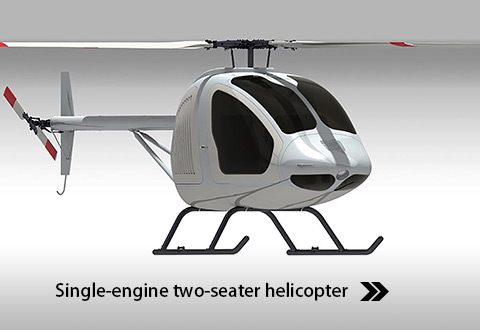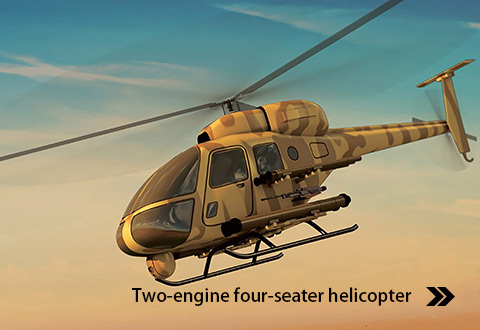-
Detailed classification of helicopters
The classification of helicopter has experienced more than half a century of development from the long conception in ancient times to the design and exploration in modern times, and finally invented in the first half of the 20th century. With the widespread use of helicopters, the technology of helicopters has also made great progress. At present, there are about 40,000 helicopters used in various fields around the world. Helicopters are also divided into different types based on different technologies and applications. I. Classification by use Helicopters can be divided into military helicopters and civilian helicopters. (1) Military helicopters include armed helicopters, transport helicopters and combat service helicopters. Class 1: attack helicopter has weapon systems on board, used to attack ground, surface (or underwater) and air targets, so it is also called attack helicopter or combat helicopter. The airborne weapon system of modern armed helicopter usually includes: anti-tank (armored) missile, anti-ship missile, air to air missile, aerial gun, rocket and machine gun, etc. According to different combat tasks, there can be a variety of weapons. Usually one type of attack helicopter has the ability to carry out a variety of weapons, can carry out a variety of attack missions, can be "a multi-purpose". However, due to the requirements or limitations of flight quality, performance and use, there are also specialized or mainly perform certain tasks. Therefore, armed helicopters can be divided into the following types: L) Smash the helicopter. It mainly attacks targets on the ground and surface. It can also carry air-to-air missiles or air guns, with the ability of air attack or self-defense, but its main mission is to cooperate with the ground forces to fight, for the elimination of enemy armor and other soft and hard targets, the implementation of fire support, which is the main use of modern armed helicopter. 2) Air combat helicopters. It can also be called "fighter helicopter ", mainly used to deal with the air target enemy helicopters, low-altitude fixed-wing aircraft or other aircraft, for ultra-low altitude (usually l50 meters below) air superiority, but also for their own transport, combat helicopter escort. 3) Anti-ship helicopter. The main implementation of attacks on enemy ship targets. 4) Anti-submarine helicopter. Equipped with equipment to search and detect submarines, torpedoes, depth charges and other weapons, the main anti-submarine operations. - When will the impact on the aviation market recover 2021-10-26
- Boeing will update flight control software for the 737MAX to address newly identified problems 2021-10-26
- The global air cargo market has entered a state of rapid development 2021-10-26
-
When will the impact on the aviation market recover
Aviation Week Network - Aviation Week has helped our industry keep pace with global developments in every major crisis since we launched the first edition of Aviation and Aeronautical Engineering on August 1, 1916, during The First World War. At present, the global civil aviation industry is facing the big test of COVID-19: which countries are facing the test of life and death? When will the market recover? Will Boeing go bankrupt? Ask directly, answer frankly, and hear Paul Burton tell it all. In an interview with Paul Burton, Managing Director of Aviation Week Network Asia Pacific, Answers a series of questions on the impact of COVID-19 on the civil aviation industry in various countries, how long it will take the global civil aviation industry to return to pre-pandemic levels, and what working life and travel will be like after the coronavirus. The interview provides a unique industry perspective on six issues. 1. The epidemic has spread all over the world. How much impact has it had on the civil aviation industry of various countries? Which countries have the most influence? Which countries are better off? Why is that? Many Asian countries have passed the peak of novel Coronavirus 2019 (COVID-19). Some countries are trying to introduce innovative ways to lift the travel ban. From China and South Korea in China and three cities in 10 loosening of some quarantine requirements, in the process of the prospective business travellers to Australia and New Zealand bubble "across the tasman" travel plan, the plan would mean allowing residents of the two countries in don't need to quarantine the down flow back, governments have started to use a breakthrough way to air travel to reopen. However, the resumption of international air travel will take longer than domestic air travel and the opening of national borders may be phased in. The European European airlines are still Mired in the COVID-19 crisis, but there is no doubt that it is time to look at how the region's air transport industry will cope and develop in the long term after the pandemic is over. Even airlines that were doing well before the Novel Coronavirus outbreak are seeking outside help. The aim is to ensure that they can survive this period and take full advantage of expected growth in customer demand after widespread travel restrictions are lifted. - Boeing will update flight control software for the 737MAX to address newly identified problems 2021-10-26
- The global air cargo market has entered a state of rapid development 2021-10-26
- Chinese airlines are weak in three areas 2021-10-26
Video
Contact:0351-3051715
E-mail:shanxizhehang@163.com
Address:West of Entrepreneurship Center, Xindian North Street, North High-tech Industrial Development Zone, Taiyuan city, Shanxi Province

Shanxi Zhehang Helicopter Industry Co.,Ltd 晋ICP备2021015105号-1 Powered by 300.cn











 13701107312
13701107312

 skype
skype 